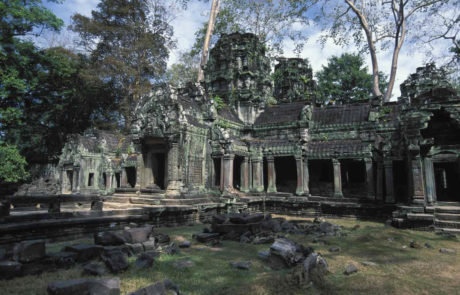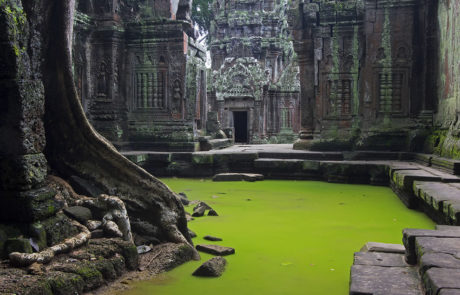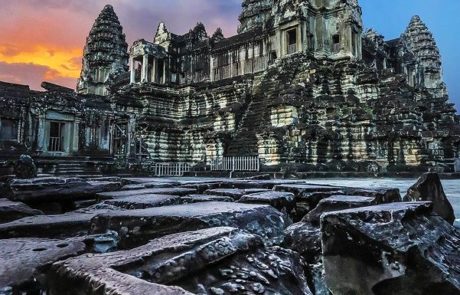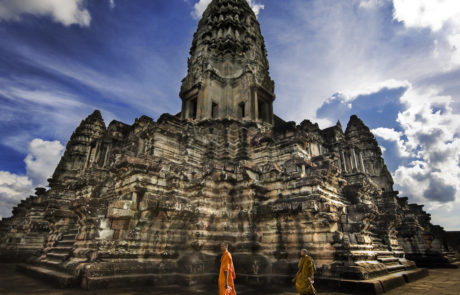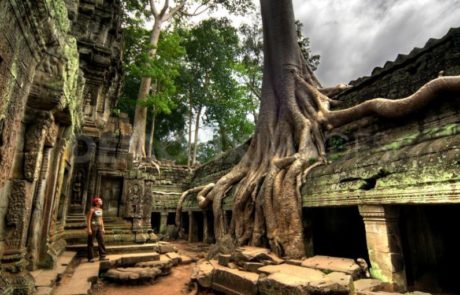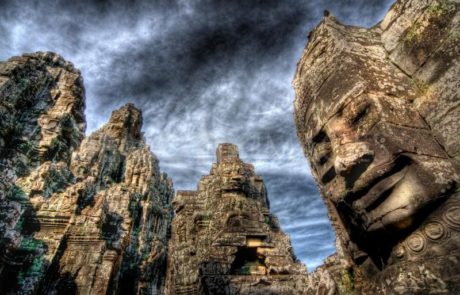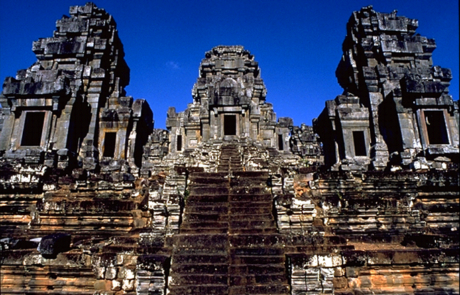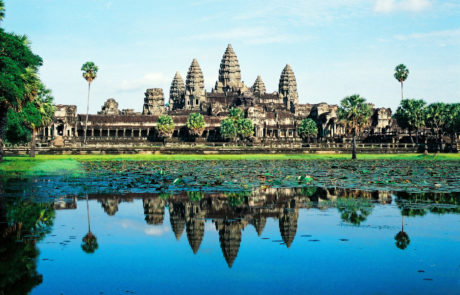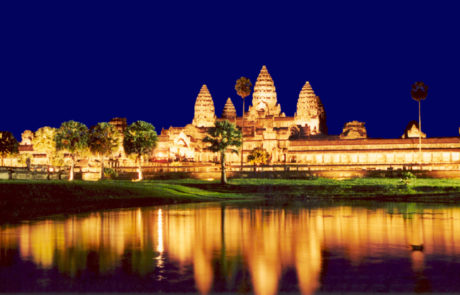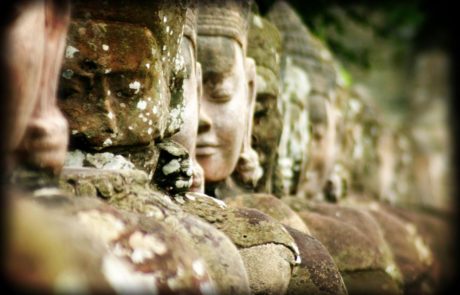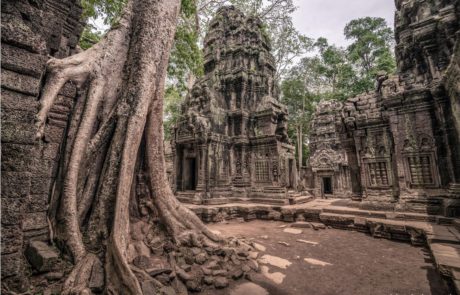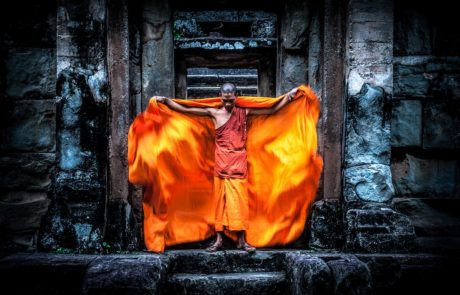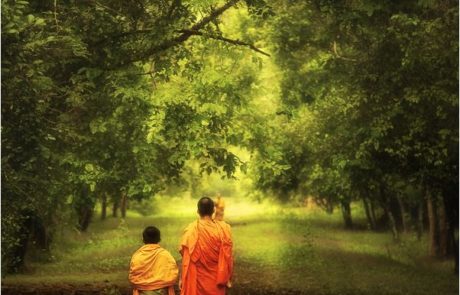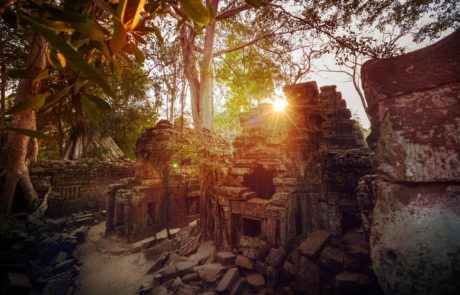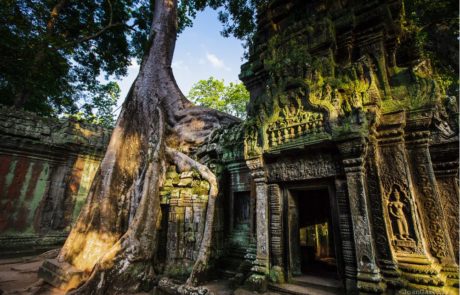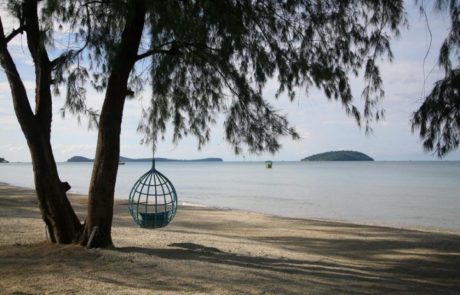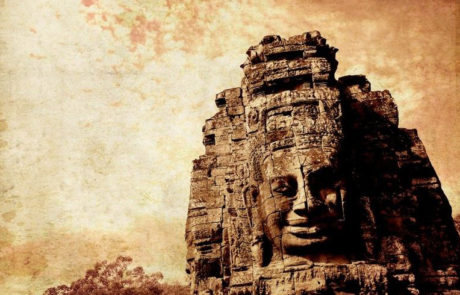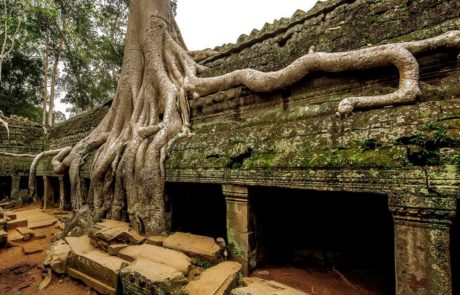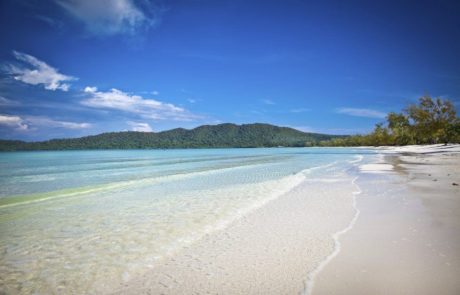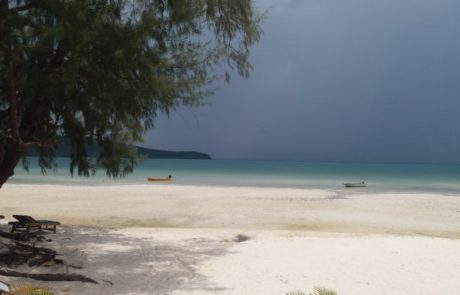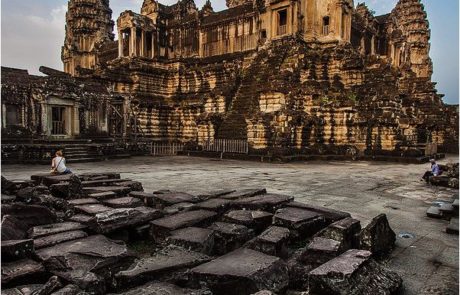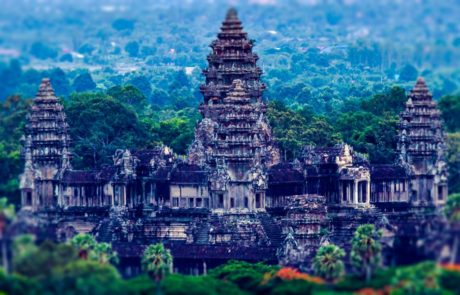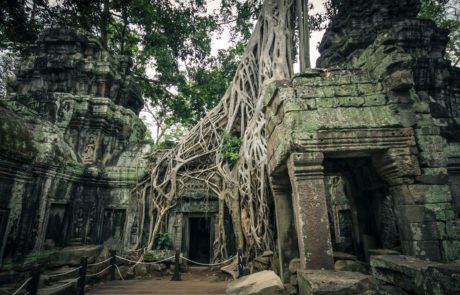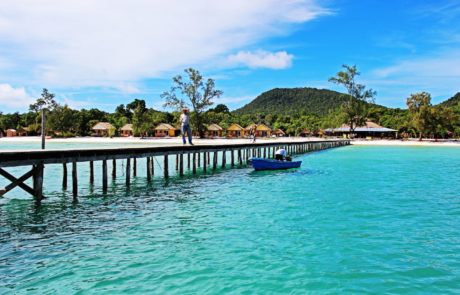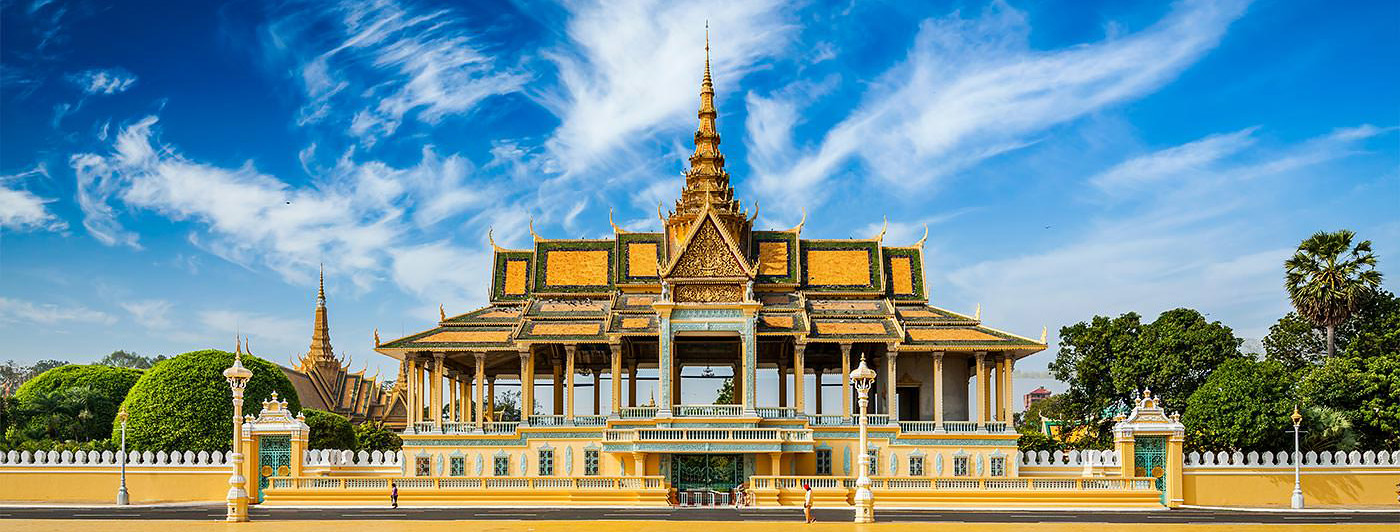
Cambodia is truly a hidden kingdom of wonder. With a glorious and mysterious past, imprinted by the “Khmer” golden age civilization to it being the home of the world’s largest religious temple, “Angkor Wat” Temple, Cambodia is the yet to see its full glory revived.
The kingdom of Cambodia occupies a total area of 181.035 square kilo-meters and lies entirely within the tropics bordering Thailand and Laos to the north and west, Laos to the northeast, and Vietnam to the east and southeast with a four hundred and forty three kilometer coastline along the Gulf of Thailand.
The kingdom of Cambodia has one of the richest cultures in Asia, the most exquisite and certainly one of the most exotic Kingdoms imaginable on earth.
Cambodian culture and tradition have had a rich varied history dating back many centuries. Over the years, the people of Cambodia developed a set of unique traditions from the syncretism of indigenous Buddhism and Hinduism.
Theravada Buddhism is the prevailing official religion in Cambodia. Approximately ninety percent of the population is Buddhists with the rest being Muslim, Hindu or Christian.
One of the most visited sites in Cambodia is the majestic Angkor Wat Temple, one of Cambodia’s UNESCO world heritage sites. “Angkor Wat”’s magical site draws an ever-increasing number of tourists surpassing the 2.5 million mark.
These are not only tourists, astronomers and architects but also worshippers from all over the world. We also have alongside the PreahVihear Temple, The Royal Ballet of Cambodia, the Sbek Thom and the khmer Shadow Theater.
Cambodia is blessed with the natural richness of tropical forests, breathtaking waterfalls, wildlife, sand beaches, Ud and exotic fruit trees. Cambodia’s industry sector produces Diamonds, hydro electric power, gas, oil, rubber and a vast cultivation of rice, corn and beans.
In short, Cambodia is a real Kingdom of wonder, a magical touristic destination and an investors Paradise.
WILDLIFE
Cambodia is home to the indigenous wildlife in Asia.
Mammals include bats, bears, cattle, deer, dolphins, whales, elephants, gaur, gibbons, horses, leopards, tigers, wild cats, monkeys, etc. Reptiles include crocodiles, tree-snakes, monitor lizards, king cobras, toads, tortoises, turtles, pit vipers, water-dragons, water snakes, etc. Birds include jungle fowl golden weavers, ibis, vultures, herons, cuckoos, eagles, flycatchers, mynas hornbills, hawks, adjutants, owls, peacocks, pelicans, pheasants, oriental darter, kingfishers, sarus cranes, storks etc.
Endangered species such as banteng, barking deer, gaur, leopards, tigers and the kouprey have been sighted off the beaten path. Koupreyls a near-extinct national animal and the world’s rarest largest mammal. Wild elephants still roam remote pristine forests. Monkeys and snakes abound in mountain areas. While the mammalian species are being threatened, conservationists strive to research, document and preserve them.
Angkor Wat Temple
Engima and fascination
Angkor Wat is a Small replica of the Universe : the central tower symbolizing mount Meru,circled with towers representing mountain tops in the midst of the lower courts which in turn represent the continents and finally “La Douve” symbolizing the oceans.
The seven headed “Naga” represents the rainbow, a symbolic bridge between Man and the home of the gods.
The Bayon
The Bayon exudes grandness in every aspects , with over two thousand large faces carved on the fifty four towers give this temple its majestic character. Its elements put side by side create a fascinating site of balance and harmony.
This three storied temple and 43m of height remained an enigma for a long time.
Built in the 12th century by Jayavarman V11, the first floors are a pantheon delicated to the Gods of Khmers while the superior floor is delicated to Buddha.
Fabulous low reliefs of one 1200m of length representing more than 11 000 sculptured people with long frescoes portraying historical events.
The Bayon remains one of the most enigmatic temples of the Angkor region.
Country details :
Official Name Kingdom of Cambodia
Area 181,035 Km2
National Independence Day 09 November,1953
Population 15 million
Annual population growth 1.54%
Density 77/Km2
Language Khmer
Religion Buddhist97%
Capital Phnom Pehn
Provinces 23
Cities 26
Khans 8
Districts 159
Communes 1,417
Sangkats 204
Country Code +855
Time GMT+7 hours
Main cities:
PHNOM PENH (capital)
Phnom Penh, once known as the “Pearl of Asia”, is the capital and the largest city in Cambodia. Home of the fabulous Royal Palace, it has a diverse economical, commercial, cultural and touristic aspect to it. Phnom Penh is Cambodia’s “many facets” found in one city. With a population of over two million people, high rise mixed use business and residential buildings, chic pubs, bistros, boutiques, art scene and a heady dusk-todawn nightlife Phnom Penh is in every way a modern metropolitan but with magic and mystery.
SIEM REAP
Siem Reap is home of the world famous site, the Angkor Temples. It includes the magnificent Angkor Wat, a UNESCO World Heritage Site, which draws over 2.5 million visitors per year, and increasing. Siem Reap is a vibrant City with beautiful modern hotels, restaurants and menus from almost every culture and bars and cafes of nearly every fashion. The PsarLeu area is where one can find great bargains in jewelry and handicraft artifacts ranging from precious stones to wonderful woodcarvings.
PREAH VIHEAR PROVINCE The Sacred Site Of PreahVihear Temple; A world Heritage
The PreahVihear is a Khmer temple situated spectacularly atop Pei Tadi, a 525 meter cliff in the Dangrek Mountains located in the PreahVihear province in northern Cambodia.
Dedicated to Shiva, the temple is unusual among Khmer temples for it was constructed along a north-south axis rather than having the conventional rectangular plan orientated towards the east. However, although the structure of this temple is very different from the temple “Mountains’ found at Angkor, it is believed to have been build to serve the same purpose which is a representation of Mount Meru the home of the Gods.
PREAH SIHANOUK PROVINCE
Named after King Norodom Sihanouk, located at 230 Kilometers southwest of the capital Phnom Penh, this province has become one of the best seaside destinations in Asia. Known for its fabulous beaches, the province is all about breathtaking scenery, wonderful seafood and water sports.
Investment in CAMBODIA:
The economy of Cambodia has seen rapid progress in the last decade. Eco-Tourism plays a key role in Cambodia, which was voted the world’s second favorite long-haul destination for British tourists at the 2009 Guardian, observer and guardian.co.uk travel awards in the UK.
Cambodia is today considered one of the favorite hosts of regional and international conferences, seminars and business meetings.
Cultural, business, sport and religious events from all over the world choose Cambodia as their favorite destination, the likes of the Johnnie Walker Golf Cambodian Open: an international golf tournament held annually in Cambodia.
We have the annual Angkor Wat international half marathon and a triathlon.
Cambodia had also hosted the Asian Tourism Forum in 2011 among other international events.
Cambodia boasts enormous economic potential and excellent incentives for foreign investment opportunities in sectors such as agriculture, Argo-industries, infrastructure, labor intensive industries, export oriented Industries, onshore and offshore oil and gas production, mining and wide tourism investment.
Cambodia is self-sufficient in rice and exports its surplus but nation-wide fertile land has not been used to its maximum potential yet. Thus with sufficient investment, Cambodia can become a key rice supplier for the region and the world.
Aside from abundant natural resources and low-cost labor, the Royal Government of Cambodia (RGC) has enacted legislation specifically designed to attract foreign investors.
To achieve its social and economic developmental goals, the RGC has looked beyond foreign aid and assistance schemes to extend generous, very competitive concessions for direct private and foreign investment.
Investment is especially encouraged in tourism, energy, physical infrastructure industries protective of the environment and industries contributing to provincial and rural development. Cambodia is an attractive location for low-cost labor intensive and export-oriented manufacturing.
The kingdom of Cambodia is one of the first in the Mekong region to set about the establishment of a free market economy. In 1993, the principle of free enterprise was enshrined in the national constitution and in 1994 the National Assembly adopted a liberal investment regime embodied in investment law.
Land ownership is restricted to locals although foreigners can lease for up to 70 years. Domestic and foreign investment is permitted by law. There is legal protection against nationalization of assets and imposition of price controls on goods and services, as well as legal assurances that capital interests and other financial obligations may be freely repatriated.
Investment projects may be 100 percent owned by a foreigner and skilled overseas workers may be employed. Tax incentives include a nine percent generous corporate income tax rate and tax exemption on profit of up to 8 years. The Real Estate development construction materials are exempt from taxes giving further relief for investors.
The Banking system in Cambodia is confirm to international norms in incoming and outgoing swift fund transfers from and to all countries.
Cambodia’s exceptional geographical position has become a coveted location for touristic investment. With its superb natural scenery, breathtaking beaches like the Sihannoukville beach, renowned for its exotic and virgin natural beauty, Cambodia has everything for all kinds of investors. The Sihannouk beach is geographically protected from natural disasters like tsunamis or typhoons due to its shielding by the Gulf of Thailand, which makes investment in Cambodia strategic and safe for local and international investors.
In the north, at only 100 Km from the border of Thailand lies the Siem Reap Province. Neighboring the Majestic Angkor wat site, a large scale land is set for development, an ideal location for a touristic real estate developmental project hosting leisure attractions, commercial zones and residential communities.
The Kingdom of Cambodia is growing in touristic, industrial and economic sectors and coupled with all the banking benefits at hand, the safe and secure environment and the new representative office headed by Kamal Agostine for the GCC and the Middle East regions, Cambodia is the ideal location for tourism and business investment.
In short Kingdom Cambodia is a “Tourist Heaven” and an “Investor’s Paradise”.
